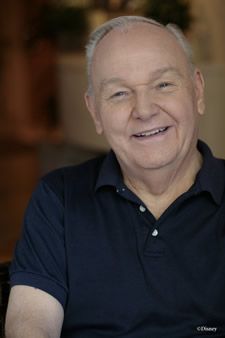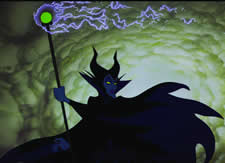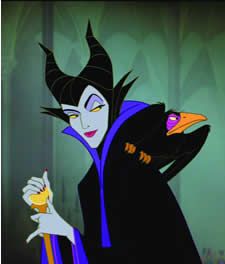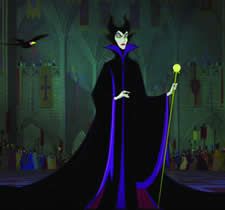
Disney animator Burny Mattinson. All pictures: copyright Disney.
Sleeping Beauty, Walt Disney’s classic tale of love triumphing over evil, has been released to mark the 50th anniversary of its original release - and it is also the first of the Disney classics to be released in high definition Blu-ray. Animator Burny Mattinson - who went on to helm the Oscar-nominated Mickey's Christmas Carol - is one of the few remaining artists still working at the studio who worked with Walt Disney. He began his career in the mailroom at the studio, after turning up unannounced one day clutching a set of drawings, but it wasn't long before he was promoted up to an in-betweener - an animator creating the bits in between key poses to ensure the 'movement' works - and by the time Sleeping Beauty came along, he was working as an assistant animator, under Marc Davis. He played a key role in the creation of Sleeping Beauty's evil witch Maleficent and we caught up with him to talk about it.
Could you tell us what your contribution to the movie - and to the Maleficent character in particular - was?
I was Marc Davis' assistant and did the follow-up work on each scene. Actually the clean-up work was done by a whole unit of assistant animators. Dale Barnhart and Art Stevens where part of this unit who were both animators. I did the rough animation work behind Marc.
What was the most important thing you've learned from Marc Davis?
He had a professionalism that was so wonderful! I tried to let it rub off on me. He was very calm and I think there's a side of Marc that I've always loved which was his little chortle - it was so endearing and made him fun to be around. Regarding animation, one of the things he told me was, "Animation was 75 per cent thinking and 25 per cent execution" and I've always used that bit of advice throughout my years in animation.
 What were the main challenges the team at Disney faced to ensure they had a unique villain character?
What were the main challenges the team at Disney faced to ensure they had a unique villain character?
A lot of it was in the writing and the fact that Maleficent was different in size and shape than the good fairies. She was more angular and her whole manner and voice contributed to her evil qualities. The headdress was striking and the color of her face and the fact that she was dressed mainly in black amd purple - dark evil colors. The three fairies were very loose and fluid and Maleficent was very controlled. All of these factors contributed to her being a memorable villain.
What is the usual timeframe for creating a villain, in this case Maleficent?
It actually starts with the concept of the story and thru the course of development, she becomes more and more focused and her character becomes more clarified. In this case it took approximately four years from concept of story to finished film. In actual animation it was approximately 18 months.
What is the most difficult about creating a character?
Certainly finding what they 'want' - you need to know what they 'want' as a character. Design is a big factor...the fact that things are sharp or edged in the design - the colors reflect her evil qualities. A voice has a lot to do with it because you can hear what's in her soul and that helps a lot. But, it's a combination of all these factors.
In your bio, you say " less is more" in animation. How did you apply that with Maleficent?
By the very fact that she moved very little - this was a stronger message than if we had her moving all around and being overly dramatic. We kept her movements confined purposely to give her a strong, evil, controlled state.
In what way were you influenced by the voice of Eleanor Audley [who provides vocals for Maleficent] and by her filmed performance?
Eleanor Audley influenced us tremendously - she did the same type of controlled voice presentation as she did in Cinderella which was slow and deliberate and she was able to reflect her character's evilness in the tones of her voice. She was a natural in that respect.
 How did you conceive, animation-wise, the relationship between Maleficent and her pet crow?
How did you conceive, animation-wise, the relationship between Maleficent and her pet crow?
The reason for having the raven was to give Maleficent somebody to talk to - otherwise, she'd just be standing there giving speeches into the air - she would have had nothing to work against. Later, we found the raven was a great device to go out and do her bidding - finding Briar Rose/Princess Aurora, when the goons had failed. The raven, also was a sycophant to her.
Had Walt any input in the treatment of Maleficent or was it all Marc Davis' vision? How were their working relationship on that character?
I think Marc certainly checked with Walt quite often on designs and approach on how to do the character, but the majority of the responsibility of the character was Marc shoulders and Walt trusted Marc implicitly. They had regular 'sweat-box' sessions in which Walt would view the rough footage and then give comments to Marc if there was something that needed change. In essence, Walt was always the director of the movie, but he would give direction to his animators in the sweat box if he had an idea on how to handle something better. Walt would act out how he saw the different characters in story sessions to convey the feeling and mood that Walt wanted to see the animators execute within the scenes.
It seems that the part of Maleficent is more dialogue oriented than action oriented. How did you deal with that aspect of the character as an animator?
We purposely kept her controlled and quiet and we let her dialogue do her acting for us. The reason for this was that we wanted to use those moments of when she exploded as accents that would frighten the audience. We kept her sweet, nice and controlled and then let her blow up on purpose.
With this movie, Walt Disney wanted to change the rounded, softer look of his earlier movies to a look that was much more stylised. Was it difficult to adapt to this new style?
Yes! It was a learning curve for all of us to design the characters to fit Eyvand's backgrounds and it took us much longer to do the animation because of it. Within the Gothic painting style as Eyvand interpreted it, he used very strong horizontals and verticals in the backgrounds so our characters had to have the straights and curves to fit these backgrounds. It was highly stylized for us to work within.
How did the wider aspect ratio of the film [it is shot in 70mm Technirama] influence the day-to-day workflow compared to the workflow of many of the standard ratio movies before then?
It caused a lot of problems, due to the fact that instead of working with 16" paper, we were working with 48" paper lengths - it slowed us down considerably. More mileage background-wise and character-wise meant more space to move a character across the screen. We had to put everything on a single frame which meant more drawings. Everything was twice as time-consuming.
 Which scene, in your opinion, benifits most from the wide 70mm Technirama canvas?
Which scene, in your opinion, benifits most from the wide 70mm Technirama canvas?
It's hard to say because the whole experience of the picture plays well in this format. The beauty of Eyvind Earle's backgrounds spread out in 70mm is spectacular. The forest sequence always played well. Wait 'til you see the Blu-ray on this - it plays out beautifully!
How do you feel about this being the first "classic" Disney film released on a high-definition format?
I feel excited - it's wonderful! I'm looking forward to all of the classic Disney animated films being on Blu-ray and Sleeping Beauty is probably one of the best to go first. We truly tried to make it a work of art when we did it, and now after seeing it in Blu-ray, I find myself enjoying it more than I ever did before. Now audiences will get to see it in Blu-ray and it's an enchanting experience.
What is the real improvement about the image and sound of this platinium vs. the previous dvd?
The most spectacular difference in the image is the Blu-ray process. Now being able to see Sleeping Beauty in such clarity and sharpness, and the fact that it's all been beautifully restored, it's a spectacular difference from past releases. Sound-wise, again, there's a clarity in the sound that has been restored that we've never had. In other words, all new technology has made it bigger and better and more wonderful.
Maleficent is one of Disney's darkest villains. Have the villains changed much over time, and which ones do you prefer working on?
I prefer working on all the villains - they're the most interesting of the animated characters. I don't think the villains have changed much. They all have an agenda of their own that has driven their greed or has made them evil. They all have their own different styles of delivery and how they react, but basically they all have evil intent.
Fifty years on, do you look at Maleficent differently from when you were animating her?
Actually, I probably like her more now than I did then - I think she is a much better villain now than at the time. Sometimes you get so close to these pictures as you're concentrating on the work, you don't think about the characters so much, but, I think she's a real stinker of a villain - which makes for a good villain.
Sleeping beauty was very influential for young animators. What was influential for you?
Working with Marc Davis and learning the craft through him. Certainly, Pinocchio was the film that influenced me and why I wanted to get into the business. Every film I worked on was a learning curve - Lady And The Tramp and then Sleeping Beauty ...all the films I worked with the nine old men on were such an experience because they had so much to offer. There was such a wealth of information on the art of animation that you were learning from them.
When I look at the villains in Disney movies I notice that a lot of the villains have a lot of purple in their color palette either skin, hair or costume color. Studies show that people associate the color purple with envy arrogance and flamboyance - is it a coincidence that villains where envy is an important part of their evilness have a purple color palette?
Maleficent was never conceived with the color purple in the beginning. It was actually Evyind Earle's decision to change the color red to purple in her garments to fit into his background palettes. There's a lot of green in Eyvind's backgrounds - especially in the forest and the castle and as purple is the opposite of green, it's a complementary color which is the best choice to work with. But, the reasons for the heavy use of purple in other characters - Ursula [the villain in The Little Mermaid], for example, she's in the greenish-bluish sea - the purple was again a complementary color choice. But, overall, purple is just a great color.
What fictional villains frightened you as a child?
Frankenstein! I remember sitting in the theatre and thinking he was coming down the aisle behind me. The other one was The Thing!
Do you think the change to CGI has been a good one - or do you share the view that some of the charm of the older 'classic' Disney films has been lost now that they are made much more quickly?
I don't think there's a difference in the time spent making a CG or hand-drawn film, it's about the same length to make, as we spend a tremendous amount of time in story development. I think the method of animation in which a story is told is not the important factor, it's just a creative choice in how you want to tell the story. The story itself is the most important part of it - that's why we spend such a long time in story development.
What's your favourite scene from Sleeping Beauty?
Scene 31, sequence 8 which was the first scene to be made in the picture. It was 43 feet long and the first scene in which Aurora is in the forest singing "I wonder, I wonder" picking berries and singing with the birds. It's memorable to me because it's the first scene done to see if the animation would work with Eyvind's backgrounds and it was critical to Walt to see if this approach would work... and the fact that I had to redo it so many times. Marc took me to a local restaurant and gave me a cake saying 'Happy 31' when Walt okayed it for final color!
 Sleeping Beauty is out to own now on two-disc Platinum Edition Disney DVD and Blu-ray disc. Click here to buy it from Amazon.
Sleeping Beauty is out to own now on two-disc Platinum Edition Disney DVD and Blu-ray disc. Click here to buy it from Amazon.





















